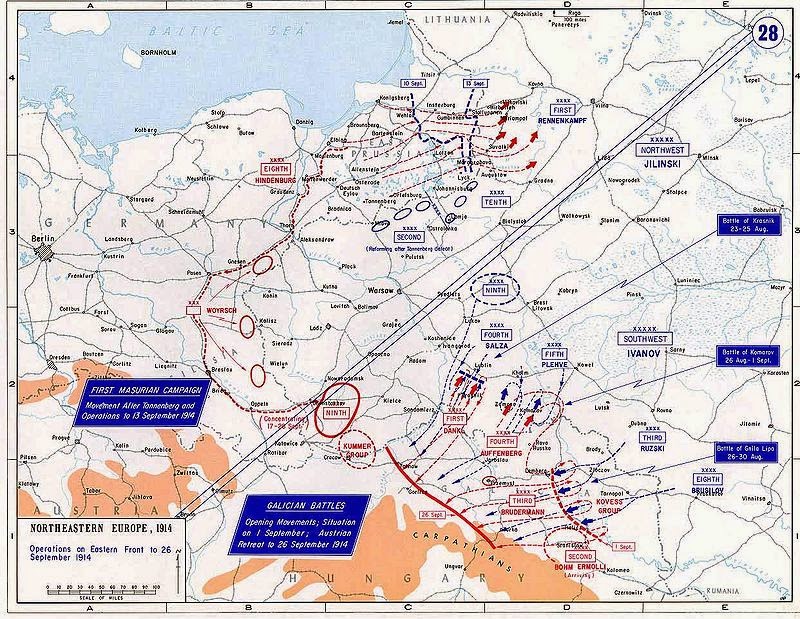Austria began hostilities by attacking
Serbia with two armies (5th and 6th) from the west, in Bosnia, and with the strong 2nd
Army on the north bank of the Danube, ready to cross into Serbia.
The
incompetent Potiorek, Governor of Sarajevo and bungler of the security for Franz Ferdinand's visit, managed to retain his position
via patronage, and commanded the invasion from Bosnia.
The Austrian 2nd Army was held north of the Danube initially, havering between
invasion of Serbia or transfer north to the Russian front in Galicia. In short, Potiorek's invasion was as
disastrous as his security arrangements. One important outcome of this was
to keep much of the 2nd Army in Serbia until the 30th August, weakening the forces Austria could bring to bear at Lemberg - an even bigger disaster than their Serbian foray.
 |
| Oscar Potiorek had a bad war, to put it mildly |
 |
| The Lemberg actions at the SW of the Eastern Front |
'Lemberg' itself was a composite battle of complex actions in several areas, fought by 3 Austrian and 4 Russian armies over 3 weeks (from 23 August to 13th September) along a 200 miles front. After some initial Austrian success, Russian reinforcements drove back the Austrians, still lacking their additional 2nd army, by nearly 150 miles. Each side lost some 500-600,000 men in several pitched battles.
In brief, the main areas were:
- The battle of Krasnik 23-25th August was the first major pitched battle. It involved the Austrian 1st and Russian 4th armies. The Austrian success in pushing towards Krasnik on the first day only made them more vulnerable to an encircling move by the Russians, led by Colonel Plehve. Although things were looking good for Conrad to the west of Lemberg, where he reinforced his armies, it was to east of Lemberg where the Russian counter-attack was gathering. From the 26th two new battles thirty miles apart began and raged. The whole Austrian front was involved.
- In the second battle – of Komarov – the Austrians looked set to encircle the Russians, but they walked straight into a massacre, which killed great numbers of Austrians, and destroyed what little faith the army had in its own prowess.
- The battles of Gnila-Lipa. Initially, on 26th August, three Austrian corps, XII, XI and IX, advanced against the Russian 8th army. Repulsed and destroyed by the Russians everywhere, they retreated to Lemberg. A second phase was fought on 30th Augustin front of Lemberg on a line of the Gnila Lipa river. The Austrians had re-grouped, and the Russians had been hesitant in following up their earlier success. However, overwhelming bombardment by the Russians broke through, and the Austrians retreated further in chaos towards Lemberg.
- Although outweighed by its crushing defeats near Lemberg, where over two million men had fought, Austria nevertheless rallied strongly at the northern end of the front, moving back towards Komarov. Indeed, by August 31st, Auffenberg was poised to take a great victory at Komarov against the Russian army, which was enclosed on three sides. Instead of closing the trap, the Austrian flanks (both controlled by Archdukes) reacted cautiously to (false) reports of Russian reinforcements, and pulled back. This left a 20 mile gap through which Plehve could retreat his army safely.
- Then on 1st September, Conrad ordered Auffenberg to turn south, and join up with the remains of the 2nd Army to take on the Russians again at Lemberg. They might have been obliterated in such an action, but for the news reaching Russia of German advances from Eastern Prussia. The Russians responded by moving much of their strength to the west towards Prussia and away from Lemberg. This led to a re-aligned front running north to south, with the Austrians stronger than the Russians in the south.
- A climax to the battles along this whole front occurred on 9th September. By the 11th, there had been huge losses, and the Russians had got in behind the northern end of the Austrian front. The risk was severe, so the Austrian 2nd 3rd and 4th armies retreated. Conrad’s order, accepting defeat, was issued at almost the same time as Moltke’s acknowledging defeat at the Marne. Demoralised after Lemberg, the Austrians fell back behind the River San, except for the fortress town of Przemysl, subject of a famous siege. They continued the retreat to the Carpathians and westwards towards Cracow and the Vistula. Conrad managed to form a defensive front before the Vistula, but it was a ragtag, polyglot army, more than 300,000 men fewer than when it had started.
 |
| "Shackled to a corpse" Two Kaisers, but a very unequal alliance. |
Effectively, Austria was now finished as a major fighting force and completely reliant on Germany. It was round
about this time that Falkenhayn made his famous comment about Germany’s alliance
with Austria akin to being “shackled to a
corpse”.
War is a fascinating subject. Despite the dubious morality of using violence to achieve personal or political aims. It remains that conflict has been used to do just that throughout recorded history.
ReplyDeleteYour article is very well done, a good read.
This comment has been removed by a blog administrator.
ReplyDelete